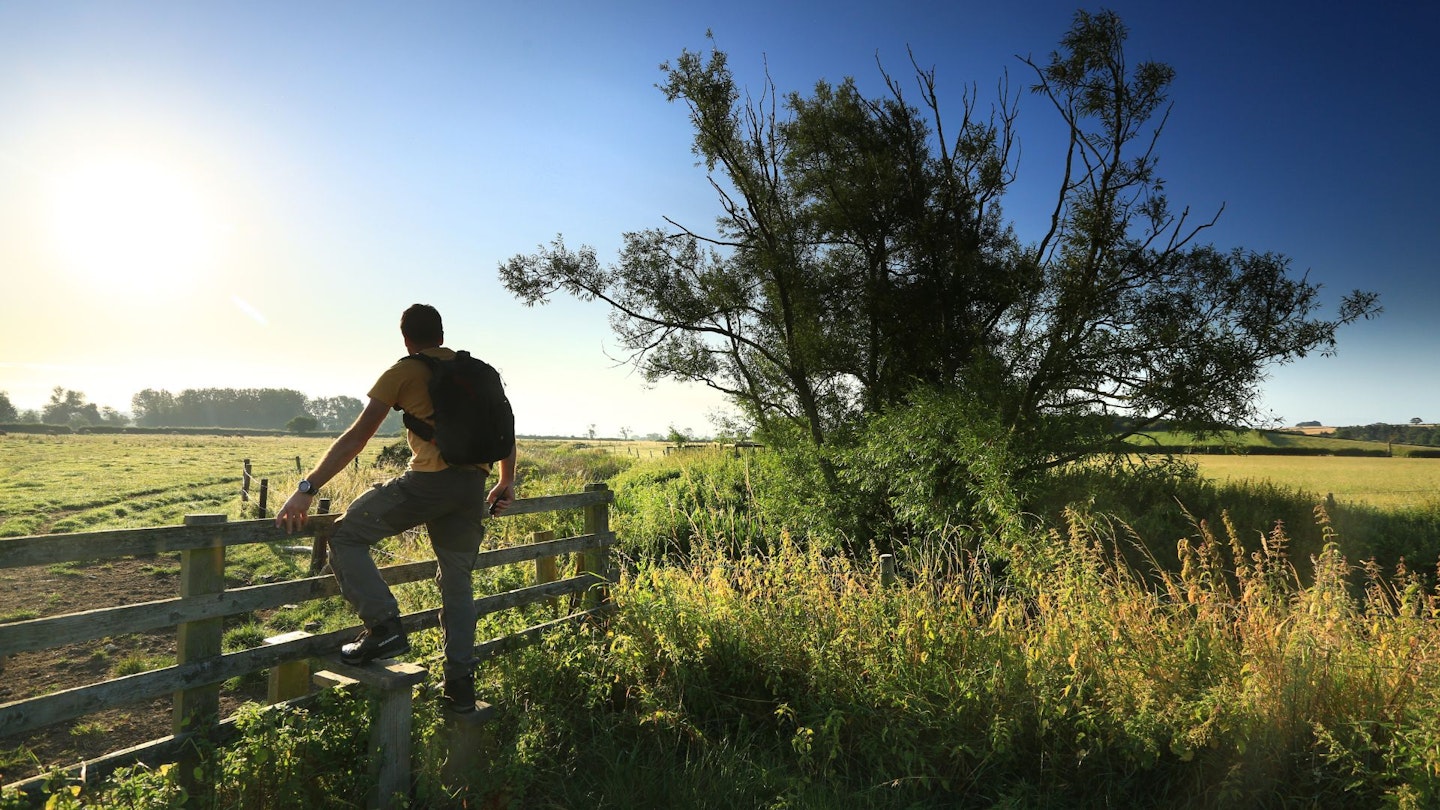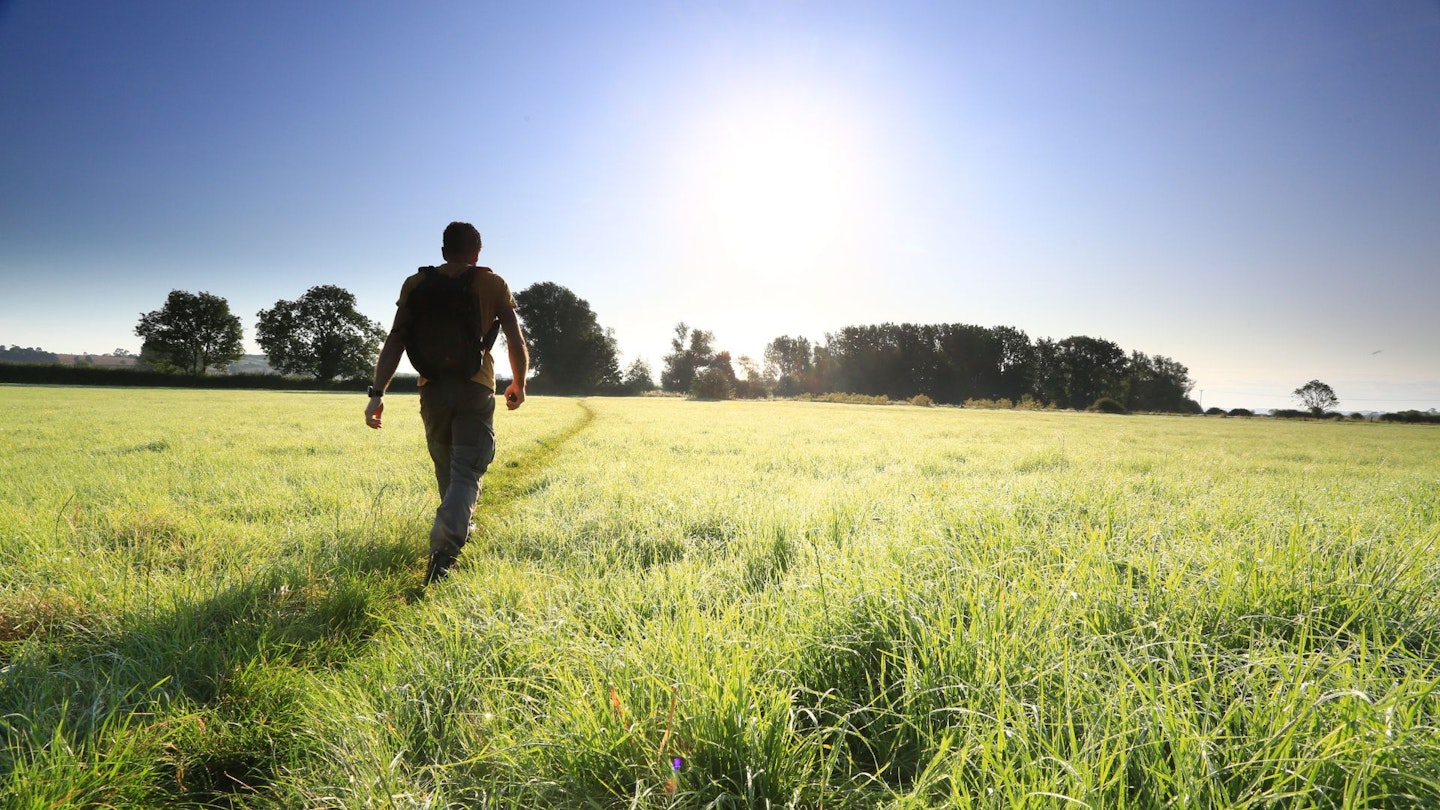Fields and farmland are the default setting of the British landscape. But, says writer and photographer TOM BAILEY, walk slow and look close, and there’s an entire world waiting for you from one hedgerow to the next. (You can also play cowpat frisbee. More on that later.)
There are probably a thousand pairs of eyes watching me. There’s a flock of rooks and jackdaws circling above the ash copse, below which maybe 50 fallow deer are hiding between the tree trunks, every head turned my way. A fox, roused from its daytime slumberings, keeps one eye alert. Then there are the small mammals, songbirds, pigeons, pheasants, raptors, insects, reptiles, amphibians…oh, and a scarecrow. Walking through the middle of a field in the English Midlands, I am the untouchable focus of all attention.

Utilised agricultural areas – or as I like to call them, fields – cover around 70% of the UK’s landmass. That’s more than 17 million hectares. But you don’t need me to tell you fields are everywhere: stretching the horizons of East Anglia, scaling the hills of the west, nudging up against the industrial estates of our urban existence. They’re so numerous I think we fail to see them after a while: they just become a background wash to the landscape. Like car parks for crops, they can be ugly in their uniformity, ugly in their immensity, ugly in their undying efficiency.
But before we all go field-blind it’s important we realise fields are our land. Traditionally it’s the land nearest a settlement that’s farmed and that has the longest history of cultivation. We couldn’t be more tied to the soil if we tried. I always feel an uncontrollable pull out into a field. It’s a solid lake, sea or ocean of soil that just has to be crossed, because you’re never quite sure what might be on the other side.
The fertile Welland Valley is a favourite fieldwalking location of mine, particularly in its upper reaches where the namesake river forms the county boundary between Leicestershire and Northamptonshire. The valley bottom is wide and the earth rich with nutrients deposited by annual flooding, while the sides and the plateau-like tops are gentle enough to be chequer-boarded with enclosed field systems.
It’s a landscape born of humankind’s endeavour to grow food, roughly split into half arable and half pasture, with those riverside fields providing particularly good grazing. And footpaths abound – traversing slopes, riding ridges and slithering alongside the Welland.

There’s a chance we’re on the cusp of a change in the way the countryside is farmed. I’d wager a fiver that food production changes drastically in the next 50 years. Yes, you’ll probably have to find me in the next world to collect on that one, but meet me by the pearly gates and we’ll look down through the clouds and see what the outcome was. Talking of the afterworld, as a kid I remember the visions of hell that used to sweep our fields and blacken the skies, when the post-harvest stubbles were ignited in napalm-like blooms of nihilism. The practice was effectively banned in 1993, and good thing too.
I’m a short way south of the small village of Stonton Wyville, where contour lines pool around a swelling in the land. The Leicestershire Round – a 102-mile route that circles the county – climbs to the hill’s 482ft/147m high point, the wide path unrolling up its north-west spur with the allure of a red carpet at a film premiere. Almost immediately it gives me field-rich views. Wheat is nearly ripe. The landscape is turning that late-summer, golden-syrup shade of harvest-time. Even the light seems yellower than normal.
Fields aren’t the only thing on the visual menu. Leicestershire has a long tradition of fox hunting and small copses of trees known as fox coverts pepper the rising ground: brief punctuation marks in the florid script of the fields. The trees allow foxes shelter (you can’t hunt foxes without a population of foxes) while the surrounding fields allowed the horse-mounted, horn-blowing hunters to give chase: the whole point of the field-sport. Again, I’m glad some things change for the better.

Today those small woodlands give shelter to much wildlife, almost in defiance of their bloody past. Trees are always a good thing, even in a feature about fields. In fields of pasture, trees in the hedgerows are often allowed to grow to their full potential, as the islands of shade they provide in summer are essential for the survival of livestock.
Unbelievably, there are about half a million miles of hedges in the UK, which begs the question: can you have a hedge without a field? You can have a field without a hedge: stone walls, wire fences, ditches and even woodland make up the majority of other boundaries. As machinery has got larger and more efficient, fields have likewise grown and the mileage of hedge has drastically reduced, with a correspondingly dire reduction in the wildlife which can seek sanctuary within its thorny entanglements.
Yet vast fields aren’t a new thing to the British countryside. We’ve never had so many, but in medieval times the open field system consisted of a massive field divided up into hedgeless strips for the peasants to farm. These would have been close to a village, while further afield (forgive the pun) common land in the form of rough heath would have been grazed by shepherded flocks and herds. These were some of the last parcels of land to be divided up and brought into private ownership as the Enclosure Act was enforced (enclosure or ‘inclosure’ of the countryside happened over many hundreds of years but was finally completed with the parliamentary enclosures of the 1800s).
The flat, broad fields of lush green grass that fringe the River Welland – its name hinting at its fertility-giving nature, well-land – are pristine in the ripening morning light. I break trail through the dew-heavy stems, leaving a dark echo of my route like ski tracks in the snow. There are no cattle in the field, just a billion green-leafed spears stuck in the earth, each encrusted with droplets of water that reflect and intensify the sun’s rays. I can’t fight off the effect this is having on my soul.
Fields do this, they allow the sun to play on the land as it does over water. The next field on my walk is full of cattle. Bullocks, in fact. A gap in the hedge for the stile lets me glimpse the bovine masses already lifting their heads in curiosity. I am otherwise blind to what the next field contains, as the hedge is high and in full leaf. Personally, I love the Russian roulette nature of moving from field to field, the shot of adrenaline as you go over the stile into a place full of other, very large, life-forms.

The first few metres of the crossing – there are at least 300 to go – see all heads come up from the grassy floor and turn my way. Little by little, they start to move towards me; soon they are all hurrying up behind me. I can feel the collective weight of the fast-moving herd through the soil, as I near the centre of the great rainforest of grass. Cows, like horses, often pick up on your vibes, so I keep mine relaxed, calm, happy. But when the herd pushes a little too close, I do what I’ve learnt to do in this situation: I stop and turn to face them. As I’ve always found, they freeze and then look away like they’d never been following me. I turn to walk on and the game begins again, stop, start, all the way to the next hedge.
Once I’ve crossed the stile, the bullocks get braver and crowd up, knowing – just as I do – that the field boundary separates two worlds. The next field is full of grass, but empty of livestock. It is also full of sh*t. The grass has been cropped short and the herd moved to pastures new, but evidence of their temporary residency is everywhere in the form of hubcap-sized cow-pats. Herbivore poo should never be taken too seriously, especially when you can play frisbee with it.
Salvation from my childlike fascination with cow dung comes at the next hedge-bound stile, as I squeeze into another new world, passing from pasture back to arable. I am drifting away from the river and from the regularity of winter flooding, when the fields I’ve just walked become sky-reflecting mirrors of tranquillity, the hedges and stiles abandoned by all except the flotsam and jetsam of the flood debris that collects at their bases. I am half the year away from such bleak sights, and golden wheat once more befriends me as I walk the path at the field’s edge.
Paths that separate hedge from field, if you’re lucky, exist in the unkempt oasis that is a wide field margin. Rank with grasses and wildflowers, these strips widen the wildlife corridor that is the hedge line. On rainy days, or dewy mornings, wet legs await the walker. My green-tinged (thanks cows!) boots are clean within minutes as I slip around the wheat. The rank uniformity of the crop looks impressively human; by contrast, the lank calamity of the field margin is a delirious joy of Nature’s doing. All is presided over by the hedge, a human-nature collaboration, where both strive to bring the other in line.

I know as I make my way through umpteen arable fields that, if the current weather holds, the next few weeks will see them change character again as the slow drone of the harvest brings the annual cycle of crop growth to its conclusion. During those dry, dusty, noisy times, the fields of pasture seem sedate and never changing, as slow moving as a cow’s thoughts. When you think about it, it’s really only us walkers who collectively populate the footpath-strewn fields of Britain. Yes, there’ll be the occasional farmer working the land, but by and large they’re ours. That’s pretty cool, especially if you try to imagine the countryside without them.
Climbing back up on the spur of land above Stonton Wyville, I look down at my now dust-covered boots as I absent-mindedly kick a flint back into the field. With the advantage of height, I find a likely spot and collect my thoughts while looking across a chequered tablecloth of land that stretches over the table’s edge and out of sight. I imagine the last two thousand years in the timelapse of my mind, the patchwork of fields changing colour, shape and size, while above the sky spun through the seasons of countless years. I could keep looking across these fields of human endeavour for hours, or days.
Perhaps a scarecrow’s life is a good one.

